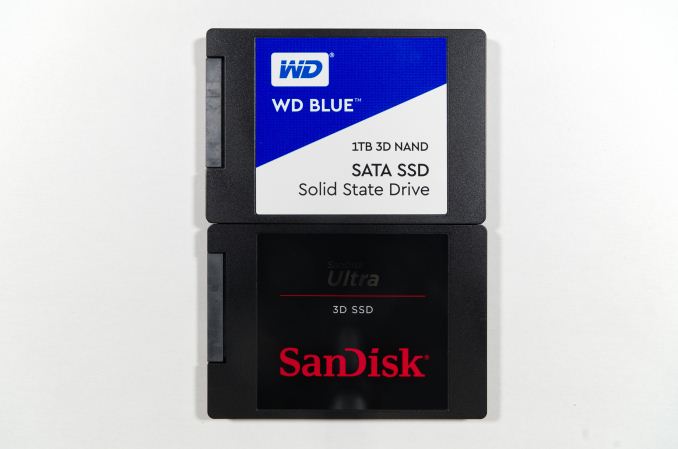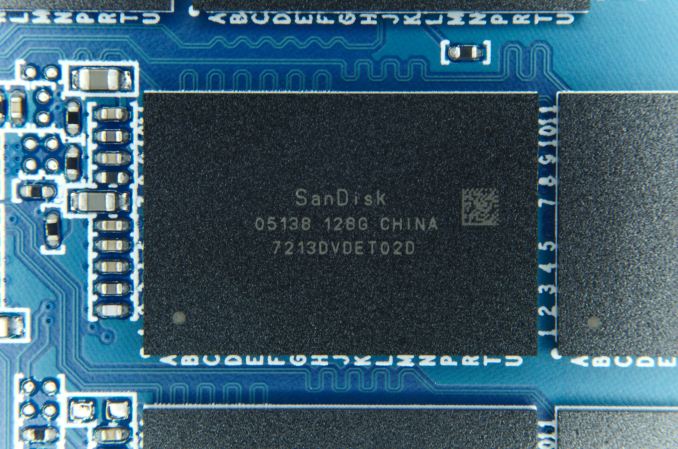One Design, Two Products: The SanDisk Ultra 3D (1TB) and WD Blue 3D (1TB) SSD Reviews, with BiCS 3D NAND
by Billy Tallis on September 14, 2017 9:00 AM EST
Western Digital, and its subsidiary SanDisk, have had some of the best performing planar TLC SATA SSD components in recent memory, so the bar is high for a new generation of SSDs. This review covers two drives which have the same design but differ in name only: the SanDisk Ultra 3D 1TB, and the Western Digital WD Blue 3D 1TB. Each drive will be targeted to the customer bases that appeal to each brand name.
The new drives don't change the basic formula that has worked in the past: the controller is the same Marvell 88SS1074 used in the original WD Blue SSD, and SanDisk is still developing the firmware in-house. SanDisk was a relatively early adopter of TLC NAND flash for consumer SSDs, starting with the Ultra II introduced in 2014. Prior to adopting 3D NAND, they had already moved to using TLC for their mainstream client drives, not just for entry level products. The original WD Blue SSD from last year used 15nm TLC, as did their flagship business/OEM SanDisk X400 client SSD.
SanDisk's 3D NAND, now in its third generation, is finally ready for mainstream SSDs. The NAND is a BiCS3 3D design, which uses a 64-layer charge trap flash design and is shared with Toshiba's 3D NAND. Western Digital has launched this 3D NAND in the retail market with a SATA drive that is being sold under both their SanDisk and WD brands. Like almost all current consumer SSDs with 3D NAND, the new SanDisk Ultra 3D and WD Blue 3D NAND SSD uses 3D TLC NAND flash.
Toshiba's version of this 3D NAND debuted in the Toshiba XG5 M.2 NVMe SSD for the OEM market, a drive we were quite impressed by. The SATA interface will limit how much the drives in this review can improve performance over their planar TLC predecessors, but there's still some room for improvement, especially around power consumption.
| SanDisk Ultra 3D and WD Blue 3D NAND Specifications | |||||
| Capacity | 250 GB | 500 GB | 1TB | 2TB | |
| Controller | Marvell 88SS1074 | ||||
| NAND | SanDisk 64-layer 3D TLC | ||||
| Form Factor | 2.5" 7mm M.2 2280 (WD Blue only) |
||||
| Sequential Read | 550 MB/s | 560 MB/s | 560 MB/s | 560 MB/s | |
| Sequential Write | 525 MB/s | 530 MB/s | 530 MB/s | 530 MB/s | |
| 4KB Random Read IOPS | 95k | 95k | 95k | 95k | |
| 4KB Random Write IOPS | 81k | 84k | 84k | 84k | |
| Idle Power (Slumber) | 56 mW | ||||
| Idle Power (DevSlp) | 5-7 mW | 5-12 mW | |||
| Write Endurance | 100 TB | 200 TB | 400 TB | 500 TB | |
| Warranty | Three years | ||||
| MSRP | $94.99 | $164.99 | $309.99 | $619.99 | |
The new WD Blue 3D NAND serves as the successor to the original WD Blue SSD, while the SanDisk Ultra 3D is a long-overdue replacement for the Ultra II. Both of the new products use the same technology under the hood; they differ primarily in the stickers on the outside of the drive and the retail packaging it arrives in. The product family includes capacities from 250GB to 2TB, and there is a M.2 SATA version available under the WD Blue branding. (The 2TB M.2 WD Blue 3D NAND has been announced but is not yet available.)
The performance and power specifications of the new WD/SanDisk drives are typical for a mainstream or high-end SATA SSD. Endurance ratings are good at slightly more than 0.3 drive writes per day, except for the 2TB model that is rated for just over 0.2 DWPD over the course of the three-year warranty.
For this review, Western Digital provided a 1TB WD Blue 3D NAND and a 1TB SanDisk Ultra 3D. Since these drives only differ cosmetically, their benchmark results should theoretically be the same. Any variations are due either to variability in our own tests, or to manufacturing variability that would be similar for two samples of the same model. We requested different capacities, which may come at a later date, although companies like to show off their best hand first - a 1TB drive is in peak of performance while not being as power hungry as a 2TB drive. It would still be interesting to get the other drives in to test, however.
This review will compare the WD Blue 3D NAND and the SanDisk Ultra 3D against the following drives:
- Last year's WD Blue, using SanDisk 15nm TLC and the same Marvell 88SS1074 controller
- The SanDisk X400, a slightly earlier drive using the same planar TLC and Marvell controller as the original WD Blue, but with different firmware and less overprovisioning.
- The Crucial MX300, Crucial BX300 and Intel 545s, representing all three variants of Intel/Micron 3D NAND that have hit the market so far. The MX300 uses 32L 3D TLC and the Marvell 88SS1074 and is the closest competitor to the new WD/SanDisk drives.
- The Samsung 850 PRO and 850 EVO, using Samsung 3D NAND and Samsung controllers.
- The Patriot Ignite 960GB, OCZ VX500 and OCZ Trion 150 (now branded TR150), all using 15nm planar NAND from Toshiba and thus comparable to the previous generation WD/SanDisk drives, but with controllers from Phison and Toshiba instead of Marvell.
| AnandTech 2017 SSD Testbed | |
| CPU | Intel Xeon E3 1240 v5 |
| Motherboard | ASRock Fatal1ty E3V5 Performance Gaming/OC |
| Chipset | Intel C232 |
| Memory | 4x 8GB G.SKILL Ripjaws DDR4-2400 CL15 |
| Graphics | AMD Radeon HD 5450, 1920x1200@60Hz |
| Software | Windows 10 x64, version 1703 |
| Linux kernel version 4.12, fio version 2.21 | |
- Thanks to Intel for the Xeon E3 1240 v5 CPU
- Thanks to ASRock for the E3V5 Performance Gaming/OC
- Thanks to G.SKILL for the Ripjaws DDR4-2400 RAM
- Thanks to Corsair for the RM750 power supply, Carbide 200R case, and Hydro H60 CPU cooler


















52 Comments
View All Comments
Rictorhell - Friday, September 15, 2017 - link
Samsung is slated to announce an updated line of new m.2 NVME SSD's at some point this month or in the 4th quarter. Their current m.2 lineup maxes out at 2tb and I've been wondering if they will release a 4tb m.2, even at a sky-high price.Smell This - Thursday, September 14, 2017 - link
Sammy's 'Data Migration' & 'Magician' tools have been bullet-proof for me.Not sure about 'Acronis True Image WD Edition' ... Acronis True Image, surprisingly, has let me down on several occasions.
metayoshi - Friday, September 15, 2017 - link
I can only speak for myself, obviously, but I've been using Acronis True Image for years with no issue. I only use the most basic features like cloning disks and scheduled backups of full disks, but for those it works just fine.mapesdhs - Thursday, September 14, 2017 - link
Billy, any idea what causes those horrible latency spikes with the VX500? They're so big, I was surprised the commentary didn't mention it.Billy Tallis - Thursday, September 14, 2017 - link
Toshiba won't disclose controller architecture details, but all of the smaller capacities of the VX500 have no external DRAM, and the 1TB has only 256GB of external DRAM. We don't know how much memory is in the controller package itself, but the 1TB VX500 certainly has less memory than a typical mainstream SSD even though it's not truly DRAMless. The VX500 also uses SLC caching even though it's a MLC drive, and that tends to lead to greater performance variability (see the Crucial MX200).Glaring_Mistake - Thursday, September 14, 2017 - link
If I remember correctly the VX500 is entirely DRAMless for the smaller capacities that instead use a small amount of SRAM (think it's 32MB).But that was not enough for the 1TB drive so it differs from the other capacitites in that it has a small amount of DRAM at 256MB.
That is still just one fourth of the usual amount of DRAM used for a drive of that capacity however.
At any rate I believe that is the reason as to why latency may suffer a bit; not enough DRAM.
eddieobscurant - Friday, September 15, 2017 - link
"Meanwhile, the SanDisk Ultra 3D offers higher write endurance ratings and lower power consumption for a slightly lower price. The Ultra 3D makes more sense for most consumers."How does it make more sense? The average consumer won't even use the 1/5th of the endurance ratings, but choosing the extra 2 years of warranty of samsung makes a lot of more sense.
Adramtech - Sunday, September 17, 2017 - link
It's amusing to see people complain about the NAND & DRAM shortage and higher prices, and simutaneously say that there's "finally" something to compete with EVO. For years memory was so cheap it put scores of companies out of business and therefore less competition to compete with the EVO. If you want competitive products, these companies need to make money to drive multi-billion dollar Fab & R&D investments. Also, there is no price fixing, the AI revolution, big data, ADAS systems are eating up all the memory and storage. Not to mention HDDs switching over to SSD everywhere you look.kavita - Monday, September 18, 2017 - link
QA Testing the comments on Production.msroadkill612 - Monday, September 18, 2017 - link
Talk about tail wag the dog.That same expensive nand, can be rigged as 500MB/s sata ssd, OR, at about 5x+ that speed if the nvme (aka pcie ssdS) interface is used.
What a waste.
Why? Until very recent AMD TR, niggardly lane quotas on platforms (not unreasonably pre nvme ssdS) mean few have much room for devices that use 4 lanes each.
Sata only sells because its the port folks have readily available on their current pc. Even so, settling for 1/5 of an expensive devices capabilities seems rich.
i.e. - u r mad to buy sata.
Far better to try hard to find a way of improving your interface than settle for gimped ssdS.
Pcie3 nvme should be backwardly compatible w/ pcie2, so by running nvme on pcie2 lanes, they ares slower, but more than double the speed of, sata, and you have invested in a non gimped drives.
While i am at it, If I were buying a ryzen, my plan would be one of each. 2x nvme ssds, on a mobo like msi's am4 x370 moboS, w/ 2x onboard nvme ports, but due to ryzen lane limits, the second must be pcie2. It yields a very fast ssd, and a very, very fast ssd. Not bad.
Thats all your ryzen lanes used after the 16x lane gpu is counted, but u have stacks of ports on the chipset for other needs.
Far better to get an m.2 port pcie adaptor card, lanes permitting, and an nvme ssd.
It grates to hear common remark "oh, dont worry, you wont perceive the nvme speed difference". Yeah right.
The champ 960 pro 500GB nvme is rated for 3400GB/s read seq & 2250~GB/s write. Like u r not going to notice if an app ever swaps out to disk or works on scratch files at such differing relative speeds. BS.
Factor in also that sata ports from chipsets are handicapped in various ways, so it pays to investigate the exact nature of the sata port you use.
A notion for some lane starved users to consider is getting by with 8 lanes for your 16 lane gpu, thus freeing up a juicy 8x pcie3 lanes. Even some gamers credibly say it works as well. Google it.